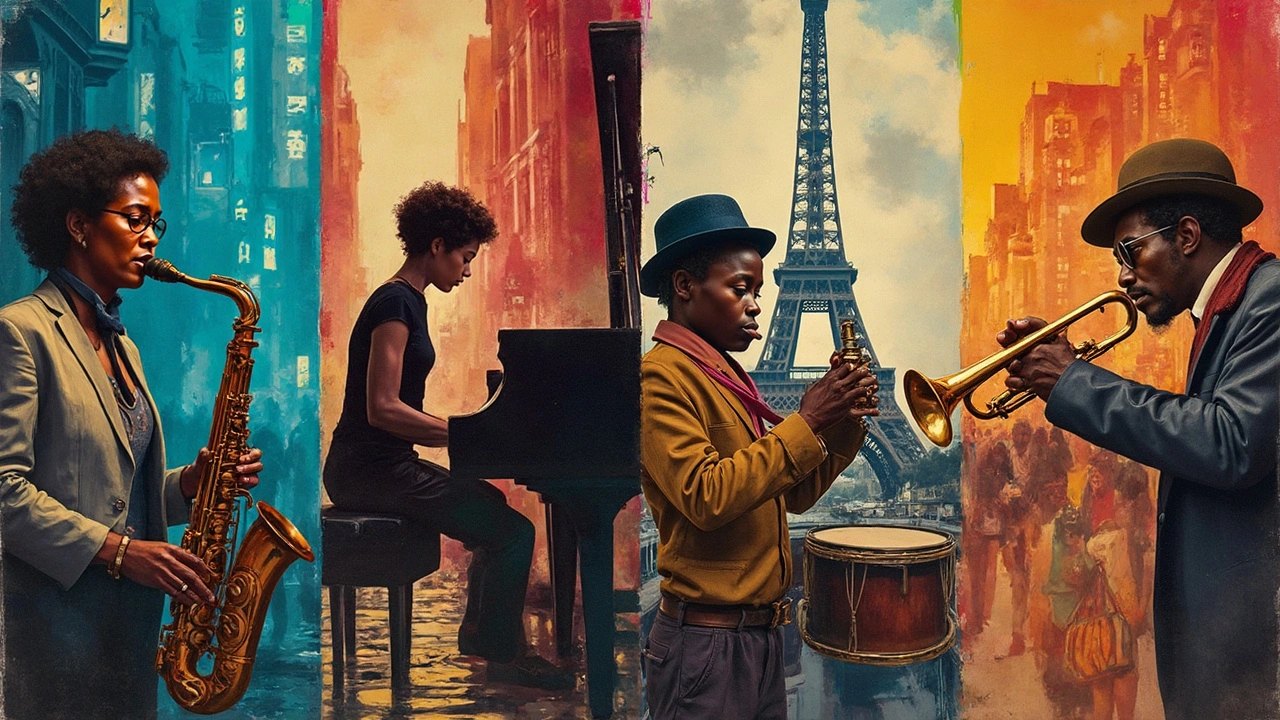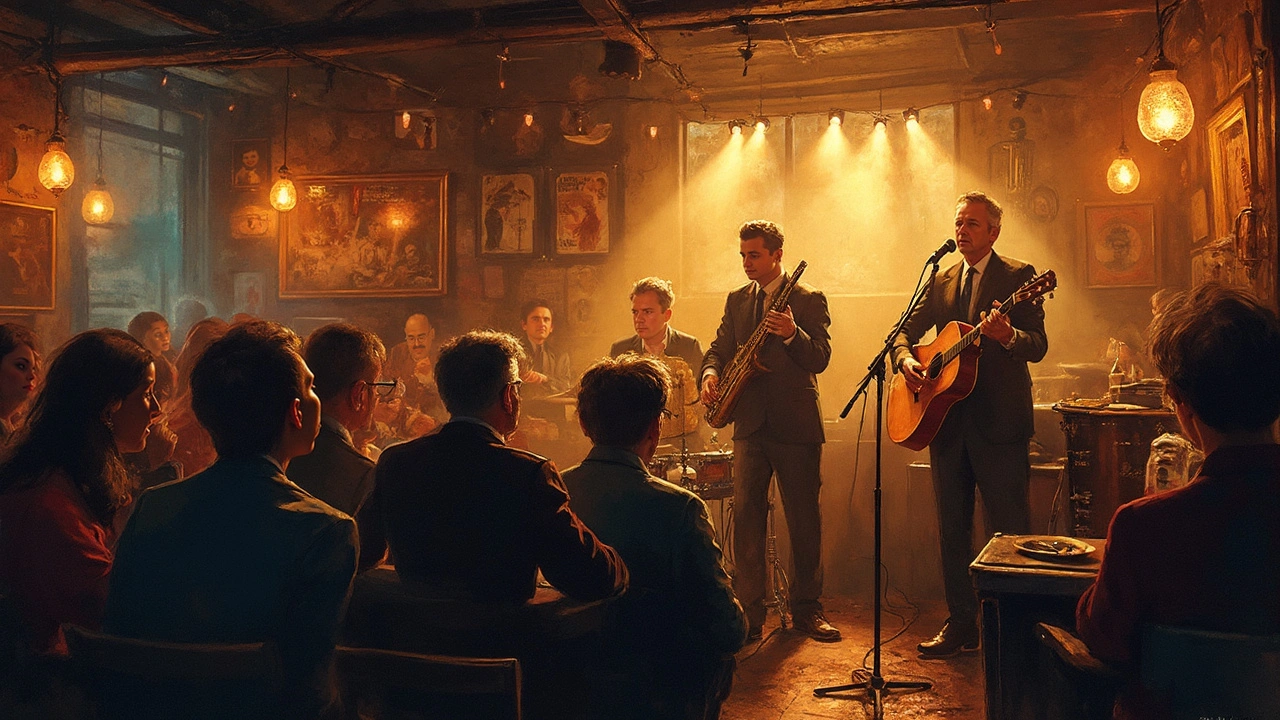Jazz might have started in New Orleans, but it grew up everywhere. No matter where you travel, there’s a local scene putting its own twist on jazz—sometimes mixing in folk tunes, sometimes adding unexpected rhythms. Curious to catch a smoky jazz club in Paris or stumble into a tiny Tokyo bar where legends perform? You're not alone.
What makes jazz so addictive is how every country does its own thing. Some keep it classic, others go wild with new sounds. But wherever jazz goes, people use it to say something real about their lives. If you want to experience authentic jazz—not the watered-down tourist version—knowing what to look for in each country helps a lot.
Don’t just rely on rating apps and big-name venues. Sometimes the best jazz happens in places you wouldn’t expect, like a bookstore in Kyoto or an outdoor café in Cape Town. Check for local events and ask bartenders or regulars for tips—that’s how you’ll usually find the hidden gems.
- America: The Birthplace of Jazz
- Japan: Mixing Tradition with Jazz Innovation
- Europe: France and the Spirit of Gypsy Jazz
- South Africa: Jazz as a Voice for Freedom
America: The Birthplace of Jazz
Everyone knows jazz got its start in the U.S., and it’s still the heart and soul of the scene. New Orleans deserves most of the credit—this city mixed African rhythm, blues, and European brass bands together at the bars and street corners. The first famous jazz recording came out in 1917 by the Original Dixieland Jass Band, but local players like Louis Armstrong, Jelly Roll Morton, and Sidney Bechet were the real pioneers.
These days, each city in America has its own jazz flavor. New York is known for late-night jam sessions at clubs like the Village Vanguard and Blue Note. Chicago brings a raw, gritty energy at places like the Green Mill, a historic spot that once had Al Capone as a regular. Head to New Orleans and you’ll find live music all day, everywhere from Frenchmen Street bars to brass band parades in the street.
Jazz isn’t just for history buffs here—it’s alive and kicking. There are hundreds of jazz festivals every year. The New Orleans Jazz & Heritage Festival pulls over 400,000 visitors annually. Other big ones include the Monterey Jazz Festival in California and the Newport Jazz Festival in Rhode Island. Here’s a quick look at top U.S. cities for jazz:
| City | Iconic Venue | Best Time to Visit |
|---|---|---|
| New Orleans | Preservation Hall | Late April (Jazz Fest) |
| New York | Village Vanguard | All year |
| Chicago | Green Mill Lounge | Summer (Jazz Festival) |
| San Francisco | SFJAZZ Center | January (Winter Fest) |
If you want the real thing, skip the tourist chains and try old-school joints or even neighborhood street shows. Ask bartenders where the local talent plays—chances are, you’ll find musicians pouring everything into their set. Nothing’s scripted, and the vibe can change night to night.
One more tip: If you’re crate-digging for records, American jazz shops usually have rare finds at better prices than online. And if you’re hunting for that classic jazz music sound, grab a live album—those capture the messy, unpredictable magic you can’t get anywhere else.
Japan: Mixing Tradition with Jazz Innovation
Japan’s love for jazz goes way deeper than most people think. The story started in the 1920s when American records and musicians landed in Japanese cities. After World War II, US soldiers brought even more jazz records over, plus instruments. What’s wild is how quickly Japanese musicians put their own stamp on jazz. By the 1960s, cities like Tokyo and Osaka had a buzz of jazz clubs where bands mixed traditional Japanese sounds (think koto, shamisen, and taiko) with classic jazz rhythms.
If you’re hunting for real-deal jazz in Japan, skip the tourist bars and try a jazz kissa. These are small, usually older cafes with huge vinyl collections—no live music, just rare records and serious fans. The Midtown area in Tokyo has some legendary spots. On the live side, Blue Note Tokyo and the Pit Inn in Shinjuku keep things fresh, hosting visiting jazz stars and local legends. Pro tip: Shows start on time and people actually listen. Don’t try to shout over the music.
Modern Japanese jazz players get creative. Pianist Hiromi Uehara is a household name now, blasting through classical barriers. Takuya Kuroda and Soil & "Pimp" Sessions blend funk, hip-hop, and Japanese melodies. You’ll hear jazz CDs playing everywhere from ramen shops to clothing stores.
| Famous Spots | City | What Makes It Special |
|---|---|---|
| Pit Inn | Tokyo | Live since 1965, known for intimate concerts |
| Blue Note Tokyo | Tokyo | Big-name guests, crisp sound, upscale vibes |
| Jazz Kissa Meg | Tokyo | Classic jazz café, wall-to-wall records |
| Mister Kelly's | Osaka | Mix of Japanese and global talent |
Japan buys more jazz CDs than almost anywhere else. In fact, as of 2022, jazz made up 10% of all music CD sales in Japan—pretty wild for a country not known for its jazz roots. If you want to dig into the jazz music scene here, try timing your trip for the Tokyo Jazz Festival in September. Local record shops like Disk Union are the spot for rare vinyl.
Want to blend in? Don’t clap between solos, just after the whole song. And don’t be surprised if you come across a jazz club in the middle of nowhere—there are hundreds dotted across Japan, even in tiny towns. Jazz here is both tradition and trend.

Europe: France and the Spirit of Gypsy Jazz
France has been a hotspot for jazz since American musicians brought it over after World War I. But the real twist came in the 1930s when Django Reinhardt, a Romani-French guitarist, started what everyone now calls gypsy jazz. He did all this with just two working fingers on his left hand after a fire injury—no joke, that’s a real part of jazz history.
Gypsy jazz isn't just another subgenre. It mixes swing, traditional Romani music, and French flair. Picture fast guitar runs, wild violin solos, and everyone jamming around a café table. No brass section, no drums—just a couple of guitars and maybe a bass. Today, the vibe still fills Paris clubs like Le Duc des Lombards or the cult favorite, La Chope des Puces, which is close to where Django used to play.
France also takes its jazz music festivals seriously. Every July, the Festival Django Reinhardt near Paris pulls people from all over the world. Jazz à Juan in Antibes is an outdoor fest on the French Riviera, perfect for summer—sunset, sea breeze, and live jazz. At these festivals, you’re just as likely to hear modern French groups as American classics or Romani family bands keeping Django’s style alive.
Want to get in on the action? Here’s how to find real gypsy jazz in France:
- Look for “jam sessions” in local Paris listings—these often run late, and you don’t need a reservation.
- Stop by music bars in the Montmartre or Belleville areas; they’re known for impromptu jazz nights.
- At record stores like Crocojazz or Paris Jazz Corner, staff usually know about underground gigs you won’t see advertised online.
Gypsy jazz in France isn’t about flash. It’s about tight-knit groups, classic tunes, and improvising everything on the fly. The scene is still powered by street musicians and family bands—usually playing music that gets people talking and dancing way past midnight.
| Top Gypsy Jazz Spots in France | City | Notes |
|---|---|---|
| La Chope des Puces | Paris | Django Reinhardt history, live jams weekends |
| Le Duc des Lombards | Paris | Modern and classic jazz acts |
| Festival Django Reinhardt | Samois-sur-Seine (near Paris) | Annual July festival, open-air, riverside location |
| Jazz à Juan | Antibes | Big annual jazz festival by the beach |
South Africa: Jazz as a Voice for Freedom
It’s impossible to talk about jazz in South Africa without talking about protest and freedom. South African jazz, or “township jazz,” became a soundtrack for a country fighting against apartheid. In the 1950s and 1960s, musicians like Hugh Masekela, Miriam Makeba, and Abdullah Ibrahim (also known as Dollar Brand) blended American jazz with local rhythms and languages. That mix didn’t just create new sounds—it helped keep hope alive for millions living under prejudice and strict controls.
The music itself was risky. The apartheid government saw jazz clubs as places where people could share ideas and build resistance. Musicians were often censored, threatened, or even forced into exile. Still, the music played on in small shebeens (informal bars) and on streets in Soweto and Cape Town.
Today, you’ll find that South African jazz still connects political passion with musical craft. Modern artists like Bokani Dyer and Thandi Ntuli carry on this legacy. Cape Town’s International Jazz Festival—often called “Africa’s Grandest Gathering”—pulls in fans from all over the world.
Curious what makes South African jazz unique? Here are a few things you’ll notice:
- jazz music usually mixes swing with African musical traditions like marabi and kwela (think pennywhistle tunes and bouncy rhythms).
- It features a lot of call-and-response between musicians, echoing African folk traditions.
- You’ll often hear jazz songs sung in isiXhosa, Zulu, and other local languages.
Want to check out the scene? Head to these spots:
- The Orbit in Johannesburg (when operating—always check if it’s open)
- Mahogany Room and Gugulethu’s kwaSec Bar in Cape Town
- Local township festivals and university concerts—these aren’t tourist traps, and you’ll get the real thing
Here’s a quick look at South African jazz milestones and impact:
| Milestone | Year | Impact |
|---|---|---|
| Jazz Epistle (first black South African jazz group) | 1960 | Paved the way for African jazz innovation |
| Exile of Hugh Masekela and Miriam Makeba | 1960s | Raised global awareness of apartheid through music |
| Cape Town International Jazz Festival founded | 2000 | Became one of the largest jazz festivals in Africa |
If you’re visiting, make time for local radio and café scenes too—sometimes the best sets aren’t even advertised. Jazz in South Africa isn’t history; it’s alive, rebellious, and always moving forward.


